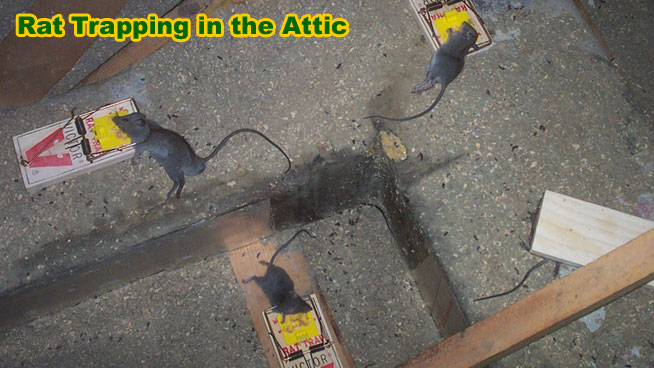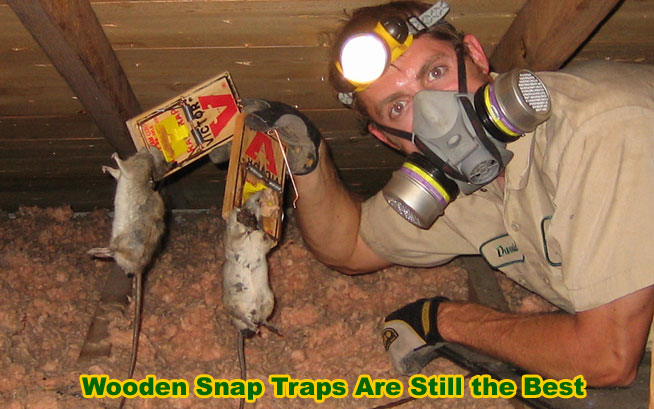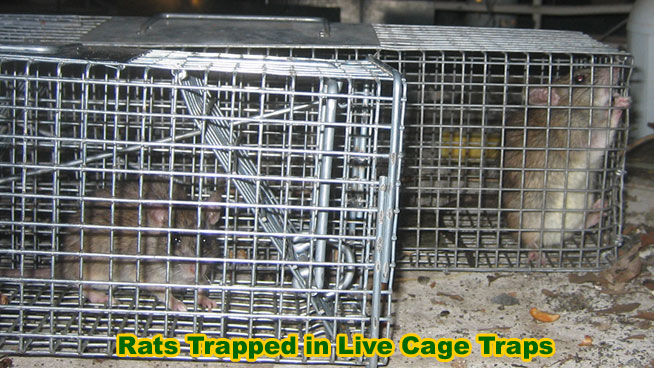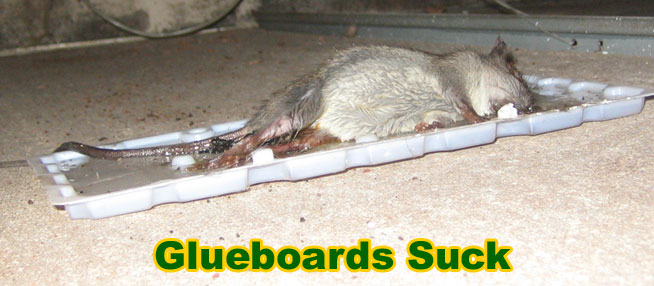Remember, the first step is crucial - you must seal up the
building first, so all the entry and exit holes are shut
before you start trapping. To trap without doing so is
pointless. Once it's all sealed, no more rats can get in,
and the ones that are stuck inside with no way out become
much easier to trap - instead of going outside for food,
they stay in the attic and run around, and hit your traps
much more easily.

I'll now discuss various trapping considerations, such as bait, location, and types of traps.
LOCATION OF TRAPS
BAIT
SNAP TRAPS

CAGE TRAPS
- The cages often don't fit in the little nooks and crannies that rats inhabit. Often, I'm wedging a trap in a small area, and a cage just won't fit.
- It's important to set many traps, at least a dozen at one time, to do the job right. Setting just one or two traps will cause several problems, because you'll have a bunch of free-agent rats with no trap to go to, and they start to gnaw and create problems. Not many people have access to a dozen cage traps.
- Cage traps are simply far less effective. Rats are cautious, and not as likely to walk into a cage trap and back to the bait trigger pan. With a snap trap, they simply run along their usual route, and WHAM, they're dead instantly. Or if it's the bait they are after, one tiny sniff, and SNAP. With the cage traps, they have to commit much more, and rats are super cautious.
- If you want to be humane, this is important - the traps MUST be checked every 8 hours or so. Rats can die quickly from heat stroke in an attic, and the stress of being in a cage trap can speed up dehydration and such. Most people who set cage traps in an attic don't have the discipline to check the traps on a frequent basis. You can negate some of the chance of death if you put fresh orange slices (a source of water) in the traps.
- Okay, say you do trap the rat in a cage, and let it go outside. It want to get back in the attic, and will sniff its way back and try to chew its way back in. If you've sealed the house properly, with steel, this should not be a concern, but still, you've got attic-acclimated rats out in the environment now. Relocating them a far distance, at least a few miles, helps.

GLUE TRAPS

Some people want to know how to keep rats away without having to trap them at all. Unfortunately, there is absolutely no effective repellent that actually works. The best form of rat prevention is to simply seal your house shut so that they can't get inside. If you need professional help, I have friends that I have personally trained in these cities:
THE SAME APPLIES TO MICE
Read more articles I wrote about rats:
What are the types of rat snap traps?
How to Make a Rat Trap
Is it legal for me to trap a rat?
Humane rat traps
Should I ever poison a rat?
An analysis of inhumane glue traps for rats
Should You Use Electrocution Traps for Rats and Mice?
Which is easier to trap - mice or rats?

What to do about a trap-shy rat
If you have rats that you can't seem to catch, you need to tweak your rat-catching method a little. Catching these animals is never going to be easy - they're wild animals, after all. They're meant to run away and evade capture. That's what they're very good at. Rats have many advantages over us humans in this battle also. They're smaller than us, can fit through much smaller gaps than we can, and can often go undetected for such a long time, they can wreak total havoc on your house before you even realize you have a problem.
In order to find out the best place to place your rat traps, you will need to sprinkle some flour down. This sounds odd, but you will soon see the tiny little paw-prints of these rats as they scurry about over the flour, and you can use the amount of dislodging as a guide. The more movement there has been on the flour, the more the rats are using that specific area. Those are the areas in which you should place the traps, not in the places where the flour hasn't been moved at all.
Another feature that will soon give the game away when it comes to finding busy rat areas, is rat droppings. They're typically rodent-dropping-shaped, and you will find plenty of them bunched together. The more droppings there are, the busier than particular area is, and the more chances your traps will have success.
When it comes to bait, peanut butter has shown to be a good one, but you could use a number of other things. Rats are scavengers, and they'll eat pretty much anything that you put out for it. You could try sweet treats, such as jam on bread, but you must remember that these foods may attract other animals also, and insects. You don't want to get rid of a rat but attract wasps, for example.
The more traps you have set, the more success you are likely to have, but you should only place the traps where it is safe to do so. The living room floor, for example, is probably not a great place, especially if the young fingers of your kids could easily be snapped by them. You should make sure you are checking the traps regularly - a couple of times per day - to ensure no dead rats are left lying around needlessly, and that they aren't lying around without any bait in them also.
There are other kinds of traps you can use if you are finding you still don't have success with the snap-traps. There are non-lethal traps, which often work with a small maze-style and plastic device, a trap set off to shut a door when the mouse or rat is safely confined within it. These often don't work as well as the snap-traps, and then give you the problem of what to do with the rat afterwards - a live one, but are another method you could try. The good news is that there is always something else you can try. If all else fails, you could always call in the professionals. It would probably be cheaper and much quicker to do that anyway …
Go back to the Rats in the Attic home page.








